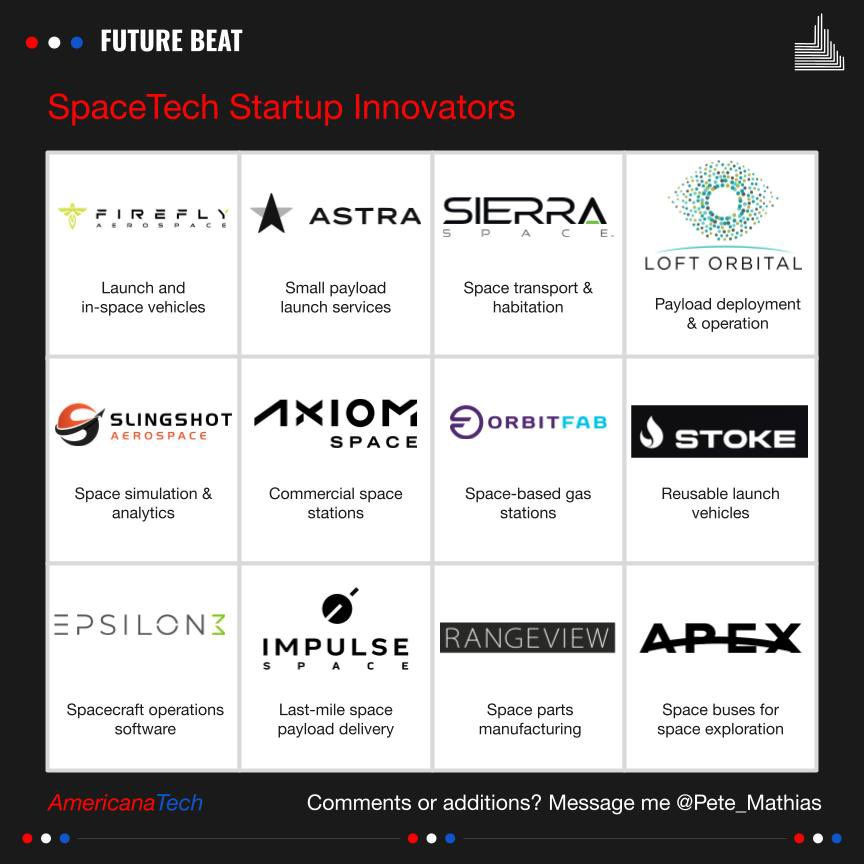What I call “Americana Tech” touches everlasting pillars of community— and country. Today I point the scope to the stars: space tech.
Context: Looking Out at the Stars
"We are all in the gutter, but some of us as looking at the stars.” Oscar Wilde’s words require minor revision these days. Now, a lot more of us— especially startups are.
What has changed since the moon landing? Mindset. JFK famously said “we choose to go to the moon not because it is easy, but because it is hard.” Today, we go to the moon and beyond not because it is hard, but because it is increasingly necessary.”
Why is it necessary? For starters: national security, scientific advancement, economic growth, and environmental management.
Challenges: New Space
There are challenges in “New Space.” Putting manned and un-manned matter into orbit is resource intensive. Reusability, payload variability (ie. large like SpaceX or small like Relativity) are engineering hurdles. Then once things are in space, novel hardware designs and applications are required infrastructure for communication (satellites, antennas), habitation, in-space propulsion, refueling, etc. Further, supporting the hardware are various software requirements for communication, refueling, imaging, debris removal, monitoring, even tourism. These present new frontier challenges.
Numbers: Space Tech “To the Moon”
A few numbers:
The annual number of objects launched to space (satellites, probes, etc) is skyrocketing:
The importance to National Security — and general global interest— is evidenced by Government expenditure on space programs in 2020 and 2022, by major country (via Statista):
The most unicorns are in 1) Communication (e.g. Starlink), 2) Small Payload Launch Vehicles (Firefly) and 3) Mission Launch Mission Services (Sierra Space).
The most active VC investors are Space Angels, Airbus Ventures, Lux Capital, Spacefund, and Founders Fund.
Illustrative Innovation: Where Innovation is Happening
Right now there are 1500+ startups innovating in space. There have been ~25 IPOs and 131 acquisitions with cities like Hawthorne, California becoming niche spacetech alleys. I segment “Space Tech” into four categories: (1) Movement, (2) Materials, (3) Monitoring and (4) Marvel.
Movement:
Use case: Getting people and things from Earth to and within Space, including Launch Vehicles and Services (including both Large and Small Payloads). This includes reusable rockets, low-cost launch vehicles, advanced propulsion systems, space elevators, balloons, and other systems that enable higher-frequency launches.
Tech used: Rockets, 3D Printing, Balloons, Nano and Cube Satellites, Materials Science, Robotics/Automation
Materials & Manufacturing:
Use case: Creation, maintenance, harvesting and removal of space-suitable materials. This includes materials components (precious metals, fuels, etc) that meet reusability, resilience (i.e. to radiation), weight and efficiency requirements of the harsh environments supporting human exploration and scientific research.
Tech used: Radiation-hardened electronics, shielding tech, self-healing materials, smart materials, 3D printing (alloys, ceramics, polymers), etc, chemicals and materials tech, gravity independent materials, thermophysics, Orbital Additive Manufacturing (OAM)
Examples: Rangeview, SpaceDots, Canopy Aerospace, Orbital Composites, TransAstra, Tethers
Monitoring:
Use case: satellite imaging, communication, debris monitoring, and other coverage of space to support missions, microgravity scientific research/ Earth observation, telecommunications, etc.
Tech used: miniature and micro-lite satellites, audio/visual tech, proximity rendezvous technology, magnetic capture
Examples: Astroscale, Astranis, SES, Terran Orbital, TRL11
Marvel:
Use case: enabling government astronauts, researchers/scientists and the public to experience, study and leverage scientific environments of space, this includes, for example, space exploration, habitation, space tourism, and space medicine
Tech used: aerospace engineering (for Low Earth Orbital), robotics (for assembly and maintenance), artificial intelligence (for testing), virtual reality (for training), life support systems including air and water filtration/waste management/food production, etc.
Examples: Sierra Space, Apex, Axiom Space
Market Map: Illustrative Startups
Here is a visualization of some of the players in the space:
Resources: Where to Stay Tuned on Space
Here are great resources to enrich your learning:
Newsletters: SpaceNews (general space news), Payload (covers the business and policy of space)
Podcasts: Planetary Radio (unique perspective from astronauts, scientists, engineers on exploration of universe), Main Engine Cutoff (space exploration from Anthony Colangelo)
Websites: NASA.gov (specifically the blogs), ESA.int (for EU Space Agency with regular great images)
Conclusion: Space Tech is Essential Tech
Pay attention to space! Spacer innovation is no longer just about national inspiration. It is about national invigoration. Macro factors like climate change, natural disasters, intensifying border tensions— space tech is becoming part of the solutions subset.
Pete
PS: would love your thoughts!
Americana Tech: A Refresher
There are at least five things that a country (such as America) must do well. These also correspond to five categories that constitute pillars of what I am calling Americana Tech: 1) Protect, 2) Power, 3) Build, 4) Move, and 5) Inspire. For my peer venture capitalists, these encapsulate familiar areas of current investment:
Protect - Tech that helps secure life and property.
How we live healthy lives - Health Tech
How we protect digital property - Cybersecurity
How we protect physical property/persons - Defense Tech
Power - Tech for critical inputs powering the economy
How we source energy - Energy Tech
How we manage resources - Forestry Tech, Agriculture Tech
How we deliver inputs - Supply Chain Tech
Build - Tech for essential hard and soft infrastructure
How we build physical assets - Construction/Infrastructure Tech
How we develop our people - EdTech, Future of Work
Move - Tech to move people and things across and beyond Earth
How we move things on Earth - Land, Sea, Air Tech
How move things beyond Earth - Space Tech
Inspire - Tech that helps win hearts and minds
How we deepen our cultural heritage - Creator Economy
How we strengthen our social communication - Consumer Social







